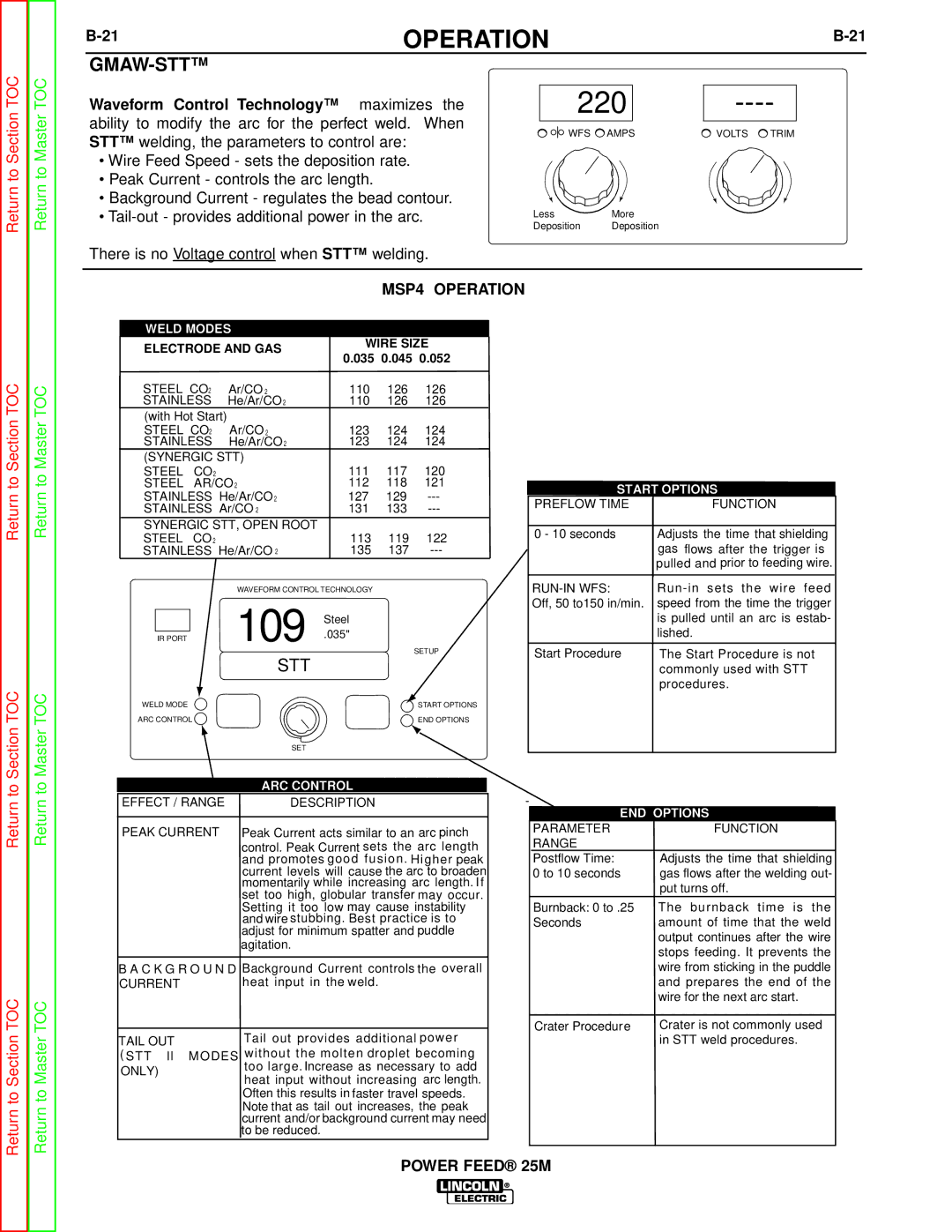
OPERATION |
GMAW-STT™
Return to Section TOC
Waveform Control Technology™ maximizes the ability to modify the arc for the perfect weld. When STT™ welding, the parameters to control are:
•Wire Feed Speed - sets the deposition rate.
•Peak Current - controls the arc length.
•Background Current - regulates the bead contour.
•
There is no Voltage control when STT™ welding.
220
![]()
![]()
![]() WFS
WFS ![]() AMPS
AMPS
LessMore
Deposition Deposition
VOLTS ![]() TRIM
TRIM
MSP4 OPERATION
WELD MODES
Return to Section TOC
Return to Section TOC
Return to Section TOC
Return to Master TOC
Return to Master TOC
Return to Master TOC
Return to Master TOC
ELECTRODE AND GAS |
| WIRE SIZE | ||||
| 0.035 | 0.045 | 0.052 | |||
|
|
|
| |||
STEEL CO2 | Ar/CO 2 |
| 110 | 126 | 126 | |
STAINLESS | He/Ar/CO2 |
| 110 | 126 | 126 | |
(with Hot Start) |
|
|
|
|
| |
STEEL CO2 | Ar/CO 2 |
| 123 | 124 | 124 | |
STAINLESS | He/Ar/CO2 |
| 123 | 124 | 124 | |
(SYNERGIC STT) |
| 111 | 117 | 120 | ||
STEEL | CO2 |
|
| |||
STEEL | AR/CO2 |
| 112 | 118 | 121 | |
STAINLESS He/Ar/CO2 |
| 127 | 129 | |||
STAINLESS Ar/CO 2 |
| 131 | 133 | |||
SYNERGIC STT, OPEN ROOT |
|
|
| |||
STEEL | CO2 |
|
| 113 | 119 | 122 |
STAINLESS He/Ar/CO 2 |
| 135 | 137 | |||
|
| WAVEFORM CONTROL TECHNOLOGY |
|
| ||
IR PORT |
| 109 | Steel |
|
| |
|
|
|
|
|
| |
|
|
|
| .035" |
|
|
|
| STT |
|
| SETUP | |
|
|
|
|
| ||
WELD MODE |
|
|
|
|
| START OPTIONS |
ARC CONTROL |
|
|
|
|
| END OPTIONS |
|
|
| SET |
|
|
|
|
| ARC CONTROL |
|
| ||
EFFECT / RANGE |
| DESCRIPTION |
|
| ||
PEAK CURRENT | Peak Current acts similar to an arc pinch | |||||
|
| control. Peak Current sets the arc length | ||||
|
| and promotes good fusion. Higher peak | ||||
current levels will cause the arc to broaden momentarily while increasing arc length. If
set too high, globular transfer may occur.
Setting it too low may cause instability and wire stubbing. Best practice is to adjust for minimum spatter and puddle
agitation.
B A C K G R O U N D Background Current controls the overall
CURRENT | heat input in the weld. | |
|
| |
TAIL OUT | Tail out provides additional power | |
( STT ll | MODES without the molten droplet becoming | |
ONLY) | too large. Increase as necessary to add | |
heat input without increasing arc length. | ||
| ||
| Often this results in faster travel speeds. | |
| Note that as tail out increases, the peak | |
| current and/or background current may need | |
| to be reduced. |
START OPTIONS
PREFLOW TIME | FUNCTION |
|
|
|
|
0 - 10 seconds | Adjusts the time that shielding |
|
| gas flows after the trigger is |
|
| pulled and prior to feeding wire. |
|
|
|
|
|
|
Off, 50 to150 in/min. speed from the time the trigger is pulled until an arc is estab-
| lished. |
Start Procedure | The Start Procedure is not |
| commonly used with STT |
| procedures. |
-
END OPTIONS
PARAMETER | FUNCTION |
RANGE |
|
Postflow Time: | Adjusts the time that shielding |
0 to 10 seconds | gas flows after the welding out- |
| put turns off. |
Burnback: 0 to .25 | The burnback time is the |
Seconds | amount of time that the weld |
| output continues after the wire |
| stops feeding. It prevents the |
| wire from sticking in the puddle |
| and prepares the end of the |
| wire for the next arc start. |
|
|
Crater Procedure | Crater is not commonly used |
| in STT weld procedures. |
|
|
